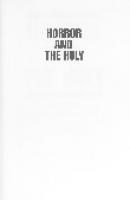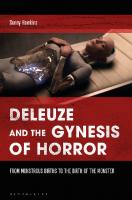Horror and the Holy: Wisdom-Teachings of the Monster Tale 081269225X, 9780812692259
Dr. Schneider draws upon a detailed and telling analysis of eleven well-known horror stories: Dracula, Frankenstein, The
131 43 22MB
English Pages 164 [172] Year 1999
Recommend Papers

- Author / Uploaded
- Kirk Schneider
File loading please wait...
Citation preview
BOSTON PUBLIC LIBRARY
HORROR AND THE HOLY
HORROR AND THE HOLY Wisdom-Teachings of the Monster Tale
KirkJ. Schneider
OPEN COURT Chicago and La Salle, Illinois
Front cover photo: Boris Karloff as Frankenstein’s Monster, from Frankenstein, Universal, 1931. Copyright © by Universal City Studios, Inc. Courtesy of MCA Publishing Rights, a division of MCA Inc.
OPEN COURT and the above logo are registered in the U.S. Patent and Trademark Office. © 1993 by Kirk J. Schneider First printing 1993
All rights reserved. No part of this publication may be reproduced, stored in a retrieval system, or transmitted, in any form or by any means, electronic or mechanical, photocopying, recording, or otherwise, without the prior written permission of the publisher, Open Court Publishing Company, Peru, Illinois 61354.
Printed and bound in the United States of America.
Library of Congress Cataloging-in-Publication Data
Schneider, Kirk J. Horror and the holy : wisdom-teachings of the monster tale / Kirk J. Schneider. p. cm. Includes bibliographical references (p.) and index. ISBN 0-8126-9224-1. — ISBN 0-8126-9225-X (pbk.) 1. Horror tales—History and criticism. 2. Holy, The, in literature. 3. Literature—Psychology. I. Title. PN3435.S36 1993 93-3634 809.3'8738—dc20 CIP
To Jurate
Digitized by the Internet Archive in 2014
https://archive.org/details/horrorholywisdomOOkirk
Contents
List of Illustrations
ix
Preface
xi
Acknowledgments
xiii
Introduction—Ecstasy, Terror, and Infinity
1
I The Structure of Horror: Chaos and Obliteration
5
Freudian and Jungian Perspectives
9
II Wisdom-Horror: Dracula and Frankenstein
13
Dracula: A Study in Hyperconstriction Frankenstein: A Study in Hyperexpansion
17 33
III Further Inquiries into Wisdom-Horror
43
Further Studies in Hyperconstriction The Phantom of the Opera “The Fall of the House of Usher” The Invisible Man The Incredible Shrinking Man Further Studies in Hyperexpansion Dr. Jekyll and Mr. Hyde The Birds Forbidden Planet Studies in Bipolar Horror Vertigo Alien
45 45 50 55 58 65 65 70 77 85 85 93
IV Horror as a Worldview Between Fanaticism and Despair: Toward a Worldview of Wonderment
99
101
Contents
Wonderment in Psychology Wonderment in Science Wonderment in Religion
103 115 121
Epilogue: A Comment on Evil
129
Notes
133
Bibliography
139
Filmography
143
Index
147
viii
List of Illustrations
Niagara Falls, Algimantas Kezys Untitled artwork, Angela Campbell
xiv 4
Bela Lugosi as Dracula
16
Boris Karloff as Frankenstein’s Monster
32
Smaller and Smaller, M. C. Escher
42
Lon Chaney as the Phantom of the Opera
46
Mark Damon as Philip Winthrop in The House of Usher
51
Claude Rains as the Invisible Man, with Gloria Stewart as Flora
56
Grant Williams as the Incredible Shrinking Man
59
The First Probe, Robert W. Vanderhorst
63
Fredric March as Mr. Hyde, with Miriam Hopkins as Ivy
64
Tippi Hedren as Melanie Daniels
71
Walter Pidgeon as Dr. Morbius, Leslie Nielsen as Captain Adams, and Ann Francis as Altaira
78
James Stewart as Scottie Ferguson
84
The Alien
92
The Crest of Niagara Falls, Algimantas Kezys
98
Circle Limit IV, M. C. Escher
128
ix
Preface
I am sitting in a dark theater watching David Cronenberg’s The Fly. Suddenly, I am struck by my fascination. How could I, a relatively temperate individual, be so fixated on the grisly events before me? How could the hundred or so patrons in the theater with me be equally entranced? How can there be so much prurient interest in general? Then it dawns on me. We are all so captivated because there are elements of the sacred in what we witness. There is an intersection here between horror and the holy! Creation, de struction, the monstrous—each of these touch on the extraordi nary as well as on the pathological. Why else would so many of us be attracted to dangerous or extreme situations—carnivals, bloodsports, mountain climbing, sex palaces, military battles? Why else would we be captivated by crime, mayhem, and cataclysm? Even in ancient times, biblical writers understood our enchantment with the macabre. But there is another reason for our fixation on the horrific: horror provides us with a view of one of the fundamental human dilemmas—that which frees us versus that which limits us. We can attempt virtually anything, the genre stresses, but we must ever be apprised of the costs. Certainly, I am not the only one to have made this observa tion. Some of us have made it intuitively, and others, like the author H. P. Lovecraft, have alluded to it explicitly.1 A few psychologists—Freudians and Jungians mainly—have also made such observations but with moderately different emphases. None of these standpoints, however, has proved satisfactory to me. Either they treat the subject too briefly, as in Lovecraft’s essay, or they don’t quite grasp the profundity of the phenome non, as in Freudian and Jungian considerations.
xi
Preface
This book, then, is written for all those who see more in horror’s unsettling domains. It is written for both academic and lay readers who perceive something momentous in classic hor ror, but who cannot find sourcebooks which fully legitimate this perception. Accordingly, Horror and the Holy opens with four psychological assumptions (which draw in part on earlier re search I have published2): (1) classic horror (and by analogy the self/cosmic relation) is both ecstatic and terrifying; (2) the basis for this condition is infinity (or “the holy”); (3) the further we pursue the ecstatic, the more we unveil its terrifying context; and (4) the encounter with this context (as opposed to the denial or passive acceptance of this context) promotes vitality and social sensitivity. After elaborating on the structure of these assumptions and their relevance to eleven classic tales, we explore their implica tions for living. Specifically, we consider their pertinence to psychological, social, scientific, and spiritual well-being. We close, finally, with a comment on the productive and unproduc tive dimensions of “evil.” One last note: To a large extent, I arrived at a spiritual understanding of life through horror—my own as well as that which I witnessed in books and movies. Although this may not be the traditional path to such a sensibility, it is a much more common one, I believe, than is ordinarily acknowledged. (Wit ness, for example, the phenomena of shamanism and the “wounded healer.”) I hope that others, who are similarly disposed, can derive benefit from this perspective and from the exalted sentiments of Holderlin: “Where danger is, the deliver ing power grows too.”3
xii
Acknowledgments
First and foremost, I am indebted to Don Cooper, whose wisdom, knowledge of film, and spirited conversations on horror have assisted me immeasurably. I am also grateful to J. A. Bricker, who thoroughly and perceptively reviewed this work in its early stages. My deepest appreciation, furthermore, to all those who have assisted me in emerging from my own horrors, and who have diversely modeled inspiring paths—among these: Edward Schiff, Ann Gustin, Debbie Hazelton, Don Rice, Jim Bugental, Rollo May, Stanley Krippner, and Sam Haramis, to name only a few. My heartfelt gratitude, finally, for the warm support of family and friends.
xiii
^$3^









